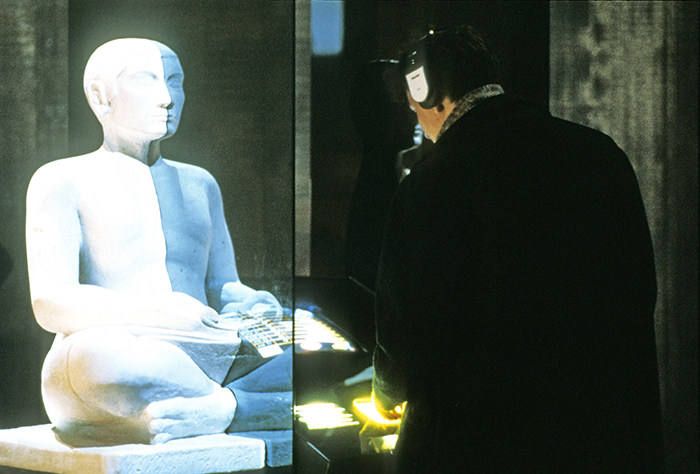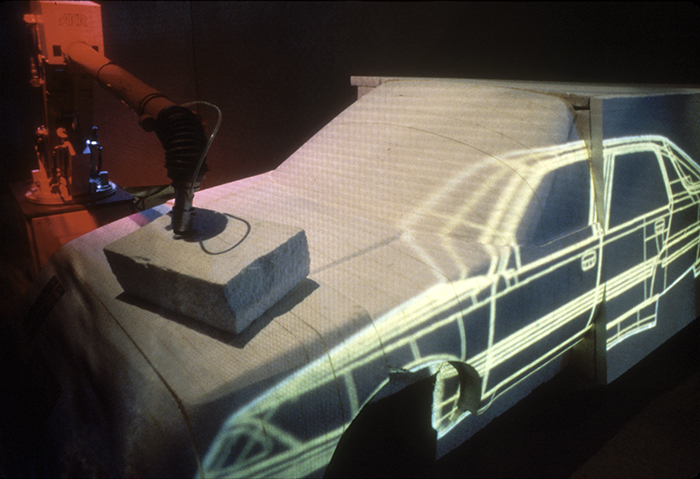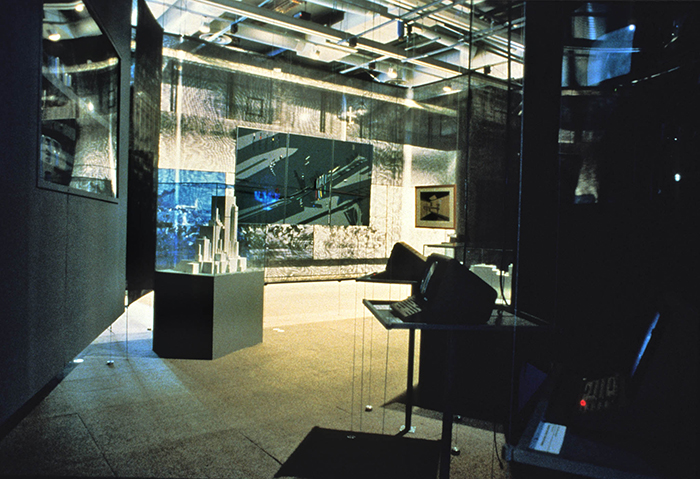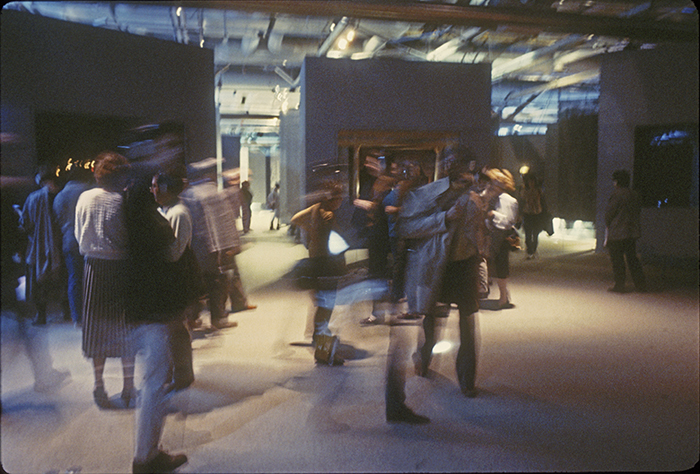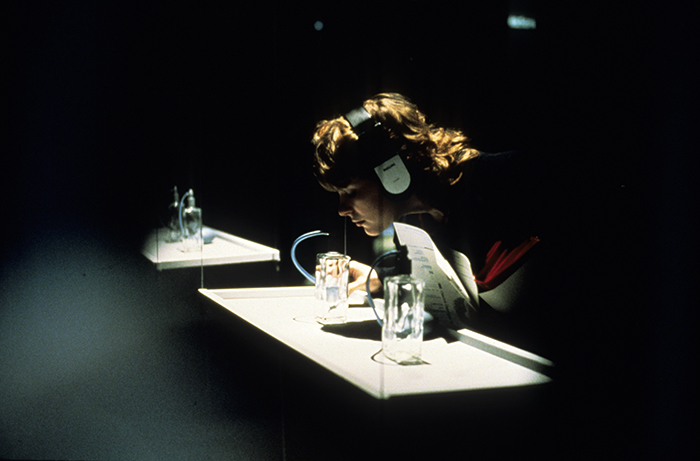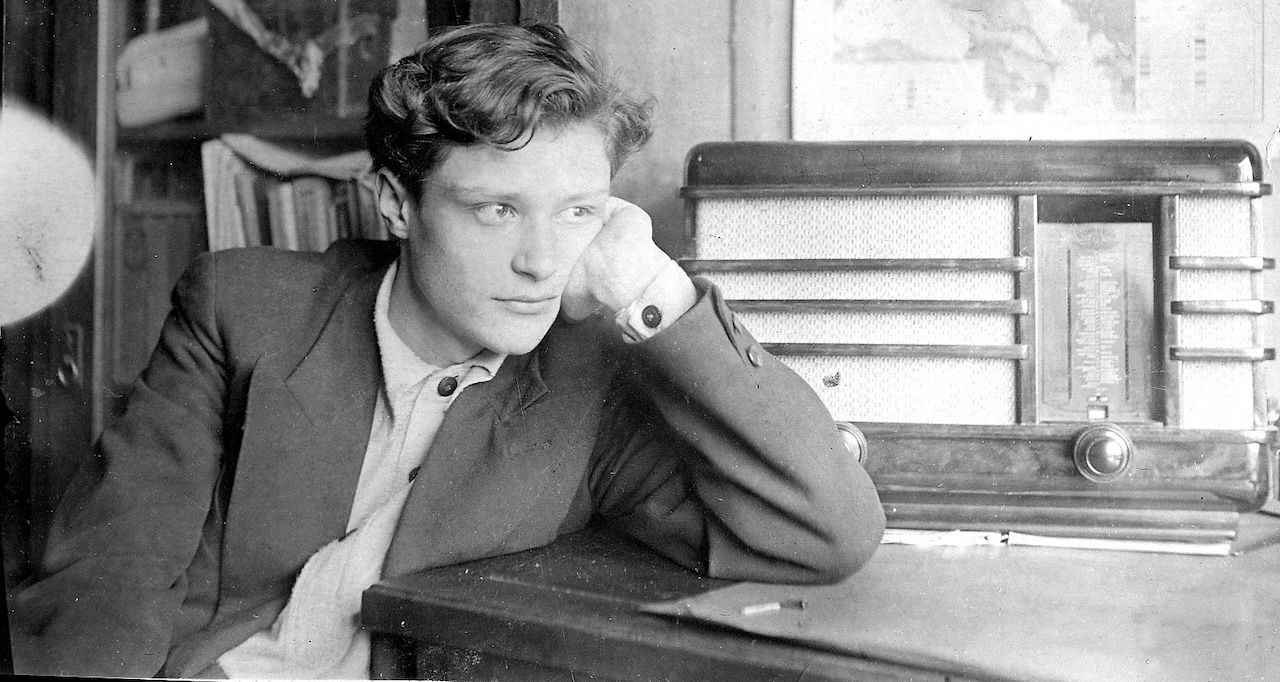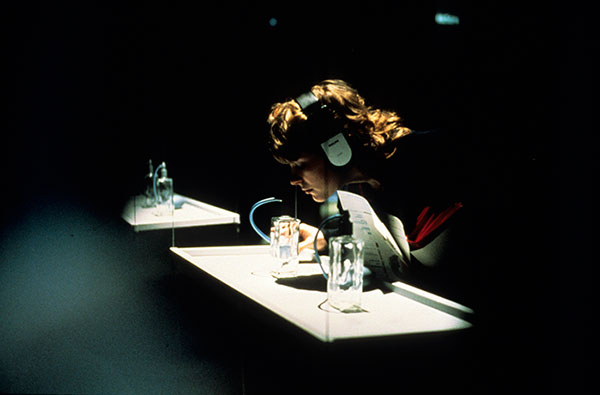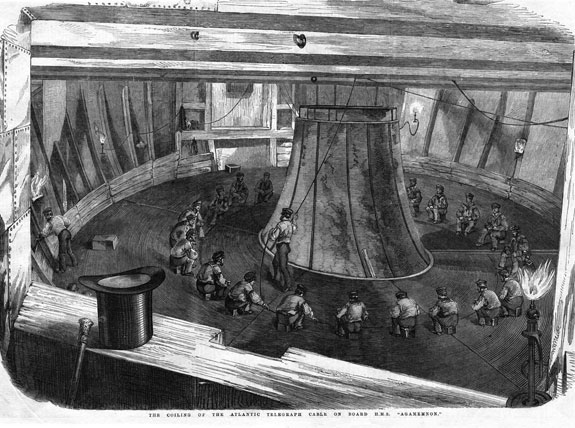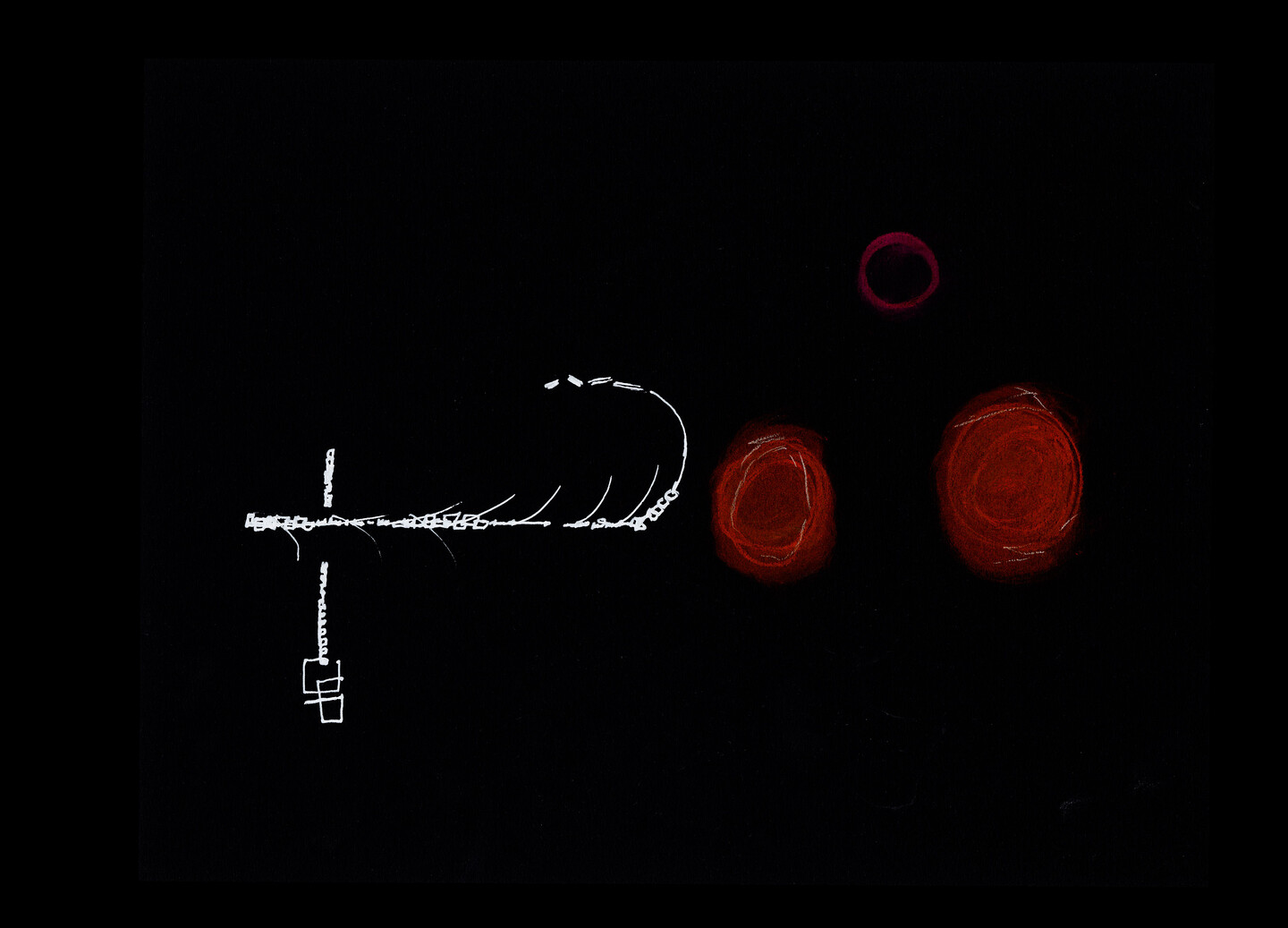From our contemporary vantage point, is there anything—whether philosophical inquiry or historical phenomenon—more anachronistic than postmodernism? Jean-François Lyotard published The Postmodern Condition in French in 1979, but the intervening three-and-a-half decades cover a period we now call “the contemporary,” even as the label struggles with each passing year to contain all that falls within its temporal and now global bounds. In March 1985, the Centre Georges Pompidou in Paris opened "Les Immatériaux," an exhibition organized by Lyotard—then at the height of his influence—and Thierry Chaput, project manager at the Centre de Création Industrielle in Paris.
While Lyotard’s attempt to convey the profoundly destabilizing experience of contemporary life via an exhibition may now seem as outmoded as the clunky IBMs he included, our current interest in new materialisms and attendant critiques of the relations between objects and humans, exhibition histories and their dramaturgies, and a spate of publications theorizing the contemporary all converge at the Beaubourg in 1985. In "Les Immatériaux" Lyotard attempted to use all the tools in his arsenal, from the latest technology to the full human sensorium, to query if and how our relationship to the world had fundamentally changed. For the tangle of conviction and ambivalence found in its gaze into the future, Lyotard’s vision for an exhibition is worth looking back on.
"Les Immatériaux" was a major event in French cultural life: it occupied the entire fifth floor of the Centre Pompidou, took two years to plan, and was the most expensive exhibition staged by the Pompidou up until that time.1 Visitors to the galleries were required to wear headphones that picked up different infrared audio signals as they navigated a labyrinthine maze of grey metal mesh screens, such that visual displays were accompanied by audio text, from Antonin Artaud to Paul Virilio, and music. The space was loosely divided into five possible paths (subdivided into no less than sixty sites), each path inspired by a word containing the Sanskrit root “mat,” to make by hand, measure, or build.2
"Les Immatériaux" roughly translates to “the immaterials” or “the non-materials.” These materials are new in that they newly challenge our relationship to the world, whether through the dehumanization of technology or by the faltering of man’s mastery over nature. And so the exhibition was filled with computers (sometimes malfunctioning), but also artificial skin and works by artists including Giovanni Anselmo and Dan Flavin. The experience was intended to be full of slippages, a bewildering dramatization of what the profound uncertainty of our contemporaneity feels like. The critics hardly warmed to such a chaotic atmosphere, yet artists who saw the show felt quite differently. “What I think was really beautiful in 'Les Immatériaux,'” Dominique Gonzalez-Foerster recalled, “was the exploration of all the dimensions of light and sound by means of infrared and text. The viewer’s movement was taken fully into consideration.”3 For Philippe Parreno, “'Les Immatériaux' was an exhibition producing ideas through the display of objects in a space.”4
The principal question Lyotard grappled with in the exhibition was: “do ‘immaterials’ leave the relationship between human beings and material unaltered or not?”5 For Lyotard, the Cartesian program so endemic in modernity was manifest in exhibitions through several conditions: first, the visitor is an eye, and sight is the dominant sense. Here, space becomes understood, ordered, and rational. Lyotard sought to undo each of these conditions. Instead of an eye perceiving space organized in linearly unfolding enfilade, he threw up all manner of barriers to vision: darkness, the grey screens, and the twists and turns of the labyrinth. Instead of privileging sight, he activated the entire sensorium. Instead of enlightenment, he aimed at “intensifying the interrogation” and “aggravating the sense of uncertainty” posed by his principal question. The immaterials had triggered a loss of our identity as human beings and led us to this state of uncertainty. In this state, and in this exhibition, Lyotard intended that we feel the dissolution of the boundaries between our bodies and the things we encounter.
Just before the show opened, Bernard Blistène, who was named director of the Centre Pompidou’s Musée national d’art moderne in late 2013, sat down with Lyotard to discuss his exhibition. An excerpt of their conversation, which appeared in Flash Art in March 1985, follows.
–Tara McDowell
Les Immatériaux: A Conversation with Jean-François Lyotard and Bernard Blistène
Bernard Blistène: Tell us about the exhibition you’re organizing.
Jean-François Lyotard: The idea of “immaterials” or “non-materials” was a little bit different at first, since I’d been asked to do the exhibition under a different title. It was supposed to be called “Nouveaux Matériaux et Creation”—New Materials and Creativity. But then I slightly shifted the subject by trying to give it a somewhat different range; I said to myself, “Creativity? What is that supposed to mean?” And again, “What is ‘new’ supposed to mean?” Thinking about “materials” today, I thought, “But what does that imply for an architect, or for an industrialist?” I came to the conclusion that all of these words have undergone considerable shifts in meaning, and I thought that the question had to be approached from a different point of view.
BB: But what can we say about the philosopher who decides that his job is to give us something to look at?
JFL: Everybody knows that books are going through a period of crisis as instruments for the diffusion of ideas, and that this is a part of the general crisis of intellectual life today, here in what we could call a kind of democratic despotism that makes for the world we live in. And of course, there’s no question of maintaining the superiority of any kind of aristocratic power, but the both of us know very well that the philosopher experiences a very grave problem with respect to the writing or recording of what he has to say, and there is a problem of the shortcomings of the philosopher with respect to the available modes of writing and recording, or of what I would call “inscription.” As far as I myself am concerned, my acceptance of the idea—to use the words with which you’ve stated it—of becoming “the philosopher who decides that his job is to give us something to look at” is something very simple and not even particularly original. I accept myself as a philosopher, and it seems to me to be important for the philosopher to be able to record what he thinks through the use of instruments that don’t have to be restricted to the instrument of the book. It’s just that simple. New and different things are at stake today, even though they’re not totally new, and we have to try to understand the things that are being offered to us.
(. . . )
BB: Could we say that you’re attempting to establish a relationship between scientific and artistic modes of thought?
JFL: Undoubtedly. The idea of artistic creation is a notion that comes from the aesthetics of romanticism, the aesthetics of the idea of genius. And I’m sure you’ll agree that the idea of the artist as “creator” is, to say the least, of strictly limited utility in our world today. That’s no longer where we really are. We’re no longer concerned with the philosophy of subjective genius and all the “aura” that goes along with it. With Duchamp, we already find ourselves in an area that has an aspect of bricolage, there’s that side where you think of him as an “inventeur du temps gratuit.”
BB: But wouldn’t you still think of the work of Duchamp as something relative rather than some kind of transhistorical value?
JFL: Well, really, both yes and no, since that’s the way it always is with art: it always has a value as an expression of its time, but there’s also a way in which it can always be perceived as lying outside of the time that produced it. There’s always something that turns art into a transhistorical truth, and that’s the part of the art that I think of as “philosophical.” It’s within this part of art that it poses the question of what it has at stake. Art, after all, is a relatively modern notion. Even Greek tragedy couldn’t have been said to be art for the Greeks—it was still something else, and it’s clear that we have to wait at least until the close of the Middle Ages to discover the emergence of an art that isn’t simply an expression, for instance, of metaphysics or religion, or political praise. What strikes me, if we can start out from Duchamp, is the way it can seem, from a certain point of view, to be difficult to be an artist if one isn’t a philosopher as well. I don’t mean that the artist will have to read Plato or Aristotle, I mean that he has to posit the question of what he has at stake, he has to ask himself about the nature of what he’s involved in doing.
Precisely this question is the most interesting thing to be found in the works of art that are strongest today, it’s the thing in which these works are most interested. What’s at stake is something that’s extraordinarily serious, and it’s not at all a question of pleasure, and not even of the way the pleasure of the sublime is intermixed with pain; it’s a question instead of a relationship to time and space and sensibility, even though I don’t like to make use of that word. What I mean to say is that certain works have a structure that keeps them from being concerned with their existence as events; they do something entirely different as an attentive observer comes away with the feeling that their engagement with the senses, if any such engagement exists at all, is of far less importance than a primary interest in the most fundamental philosophical question of all, “Why does something happen, rather than nothing?”
BB: And that is the point where we find a lack of differentiation between technological experimentation and the questions posed by art?
JFL: Even the most modest tinkler with software has an attitude that’s somehow “artistic”—an attitude of a kind of astonishment. And what that means is that metaphysics, as Adorno puts it, goes into crisis at much the same time as the rest of classical philosophy and that there’s a way in which it is going under as a result of a decline in the capacity it can have for the creation of wide-ranging global systems that include the great and final issues for which we feel a need. If there’s a decline of metaphysics, there’s also a decline of everything that people in general call philosophy. And this decline—which is something that Adorno grasped quite clearly—shows us the history of the diaspora of philosophy as it wanders through domains that can’t be properly defined as philosophical, even though the domain that can be properly defined as philosophical continues to exist. What this means is that metaphysics, as Adorno puts it, goes under, along with classical philosophy, even though certain people continue to practice it as though it weren’t in crisis at all.
(. . .)
BB: Your texts on “painting” go from Adams to Buren, and from Monory to Arakawa. They seem to contain what I’d call the logic of discontinuity. Can you say something about the reasons that have prompted you to write about certain painters rather than others? And do you think of your essays on painting as fragments of a whole within your work as a writer?
JFL: I’d answer quite simply that it has been something of a question of chance. I’m usually acquainted with the painters whom I decide to write. I’ve worked along with them, and I’ve seen them at work, but then again, there are obviously painters with whom I’m personally acquainted but whom I’d never want to write about. It’s not that I can give you an answer simply by saying it’s a matter of people I’ve happened to meet. And if you ask me if these essays are part of some single thing, and if this single thing is part of my reflections as a philosopher, I’d have to answer in much the same summary way and that for the moment I think of all these various short texts as the beginning of a kind of dossier that could lead to some substantial study not so much of art, but specifically of painting. Contemporary painting. And my goal would be to attempt to define the nature of a possible philosophy of art today.
BB: You mean that you don’t at all exclude the idea of writing a theory of aesthetics?
JFL: I don’t think it would be a question of a theory, and I don’t think it would be a question of aesthetics. I don’t think it could be a theory since I think of the idea or theory as belonging to the area of metaphysics, which we were saying is now in decline, and I don’t think of it as a question of aesthetics, since I don’t think that aesthetics corresponds to the time we live in. Aesthetics primarily appertains to a very precise moment in the commentary on art, which is to refer to the Age of Enlightenment and to what follows after it, so it’s a question of something in the order of two centuries ago. Basically, I’d be ready to maintain that there wasn’t any such thing as aesthetics up until the eighteenth century, and that up until that time there was only a series of poetics. Aesthetics actually corresponds to the philosophy of the sublime and to a theory of genius.
BB: In the light of what you’re saying, do you think that Adorno could give an explanation of the title of his book?
JFL: No, I don’t think he could. I think that his title… how can I put it? I think his title is bad but that his book is very good. And that’s precisely because it isn’t at all a theory and has nothing to do with aesthetics. This is the line of thought into which I’d like to situate this work, and I’d want it to be a kind of prolongation of what’s indicated in Adorno’s work. But, you know, whenever I reread Adorno, I always see that his approach is negative, and almost always cynical, which is the measure of the breadth of his despair. It’s the measure of the strength of the attachment still to be felt for modern aesthetics, the measure of the strength of the attachment still to be felt for modern aesthetics, the measure of a refusal to go into mourning for the final death of it. With Adorno we’re within the sphere of melancholy. You can’t forget the context in which that book was written. The most admirable parts of German art were being burned in public, and the most intelligent parts of literature and the arts were being persecuted. We no longer live under that kind of despotism, but today we can see we live under a kind of democratic despotism of the media, which is of course, something very different. And so, even though there’s nothing that has been forgotten, we have to attempt to work our way into the philosophy of contemporary art by completely disengaging ourselves from romantic aesthetics. And so this reflection on art begins for me with “Discourse-Figures” as a way of starting to palliate—or rather to supplant—the political thinking of the present day.
Basically, the most essential question of all for me, is the question we’ve just been talking about: “What do we do if we no longer have the prospect of emancipation? What sort of line of resistance can we have?” When Zola took part in public affairs, he knew exactly what he was talking about, he was aware of his “prospects of emancipation.” The same thing was true for Voltaire, and for Fourier, who was also a political thinker, and it was still true for Sartre, even though Sartre was wrong. We intellectuals are no longer capable of any kind of real intervention. And so what is our line of resistance if it’s no longer a question of a prospect of emancipation? I think that it’s something that’s very closely connected to artistic activity, or philosophico-artistic activity. It’s something that has to be thoroughly explored by asking ourselves what’s happening at the level of time, space, and the social community in contemporary art. That’s what I’ve been trying to explore by means of these various small texts that I write on art, and sometimes of music, when I feel sufficiently audacious. I’d like to write a commentary on Paris, Texas [1984] and say that it’s an Alice in the Cities [1974], which is not poor art anymore.
BB: Let’s go back to your exhibition “Les Immatériaux” and to the concept behind it.
JFL: We arbitrarily and quite purposely created a kind of filter, since there were so many things to exhibit that our very first worry was about how to go about dealing with it all. There was never any pretense of doing some sort of universal exhibition. Universal exhibitions are no longer possible, and that’s more than just a question of budgeting. And so what were our criteria of selection? They were on three different levels. First of all, we wanted to exhibit things that inspire a feeling of incertitude: incertitude about the finalities of these developments and incertitude about the identity of the human individual in his condition of such improbable immateriality. That’s a criterion of selection that’s concerned with the philosophical stakes of the exhibition. Then we obviously had to give attention to the arrangement of the show in terms of time and space. And here we appealed to two principles: no fancy mouldings and no pedestals. We didn’t want still another re-evocation of a gallery or a salon, by which I mean an arrangement of rooms in a royal palace as designed by the king. We wanted to avoid this way of squarely defining things and we had to discover a more fluid and immaterial system for the organization of space.
(. . . )
BB: Is there a postmodern formalism?
JFL: That depends on what you mean by “formalism.” Personally, I’m not very deeply acquainted with the painting that’s now generally referred to as “postmodern.” I can only say that it strikes me rather unfavorably. These forms of painterly expression that one now sees returning, these transavantgardists, or let’s say neoexpressionists (which is what the Germans call it, and they’ve had quite a lot to do with it) seem to me to be a pure and simple forgetfulness of everything that people have been trying to do for over a century: they’ve lost all sense of what’s fundamentally at stake in painting. There’s a vague return to a concern with the enjoyment experienced by the viewer, they’ve abandoned the task of the artist as it might have been perceived by a Cezanne, a Duchamp, or by any number of others, such as Klee, for instance. I see it all as an enormous involution. It’s possible that the way I diagnose things could be wrong, but…
BB: How do you feel then about the attempt to rehabilitate “technique” and “métier” as primary values for the judgment of an artist?
JFL: It would be a little paradoxical to reduce the history of a painting to a single problem of technique or supports. In any case, that’s far too little. Do you remember those extremely incisive texts by Diderot, like the one he called “La petite technique” not without a certain air of disdain. And if Chardin, for example, was far beyond his contemporaries even though they were technically his peers, one surely has to explain that in different terms from a phenomenological point of view. And look at Cezanne: he wasn’t exceptional from any technical point of view, and yet, at the same… But even though I’m not at all tempted to take these problems of technical mastery any too seriously, I’m in any case quite concerned with the aspect of technique when it comes to trying to understand the way it can affect a viewer and modify the course of his attempt to make use of his sensibility as the instrument of some kind of exploration. I imagine that someone from Flanders who made a trip to Venice in the sixteenth or seventeenth century must have been terribly shocked. But apart from that kind of consideration, we still have to realize that we’ve been witnessing a permanent process of reformation in the individual’s ability to see and then to love what he sees. But that’s not at all the situation to be seen in the majority of the works that are being produced today. They don’t teach me anything. I say to myself, “I’ve already seen that, and I’ve already seen it done better.” The overemphasis of the hand, the agitated drawing, and all the rest of it, we already know that, and we’ve already seen it. I’m not saying that it’s entirely without interest. I’m just saying that it’s without any interest to me.
(. . .)
BB: What, finally, is postmodernism?
JFL: My work, in fact, is directed to finding out what that is, but I still don’t know. This is a discussion really that’s only just beginning. It’s the way it was for the Age of Enlightenment: the discussion will be abandoned before it ever reaches a conclusion.
The full text of this conversation originally appeared in Flash Art, no. 121 (March 1985), pp. 32–39. This excerpt is reprinted with the kind permission of Flash Art.
Editors' note: the introduction was updated in June 2023.
For a superb account and analysis of the exhibition, see Antony Hudek’s “From Over- to Sub-Exposure: The Anamnesis of Les Immatériaux,” Tate Papers 12 (October 2009). http://www.tate.org.uk/research/publications/tate-papers/over-sub-exposure-anamnesis-les-immateriaux.
The matériau path, for example, began with the Nu vain (Futile nude) and led to subsequent rooms titled “Second Skin,” “Angel,” “Singing Body,” “Fragmented Body,” “Infrathin,” “Untraceable Surface,” “Indiscernables,” “Dematerialised Material,” “Neon Painting,” “Painting without Body,” and “Every Copy.”
This recollection is cited in Hans Ulrich Obrist’s essay “After the Moderns, the Immaterials,” The Exhibitionist 5 (January 2012).
Philippe Parreno and Hans Ulrich Obrist, The Conversation Series 14 (Cologne: Walter König, 2008), 17.
Jean-François Lyotard, “Les Immatériaux,” Art & Text 17 (1985), 48.
